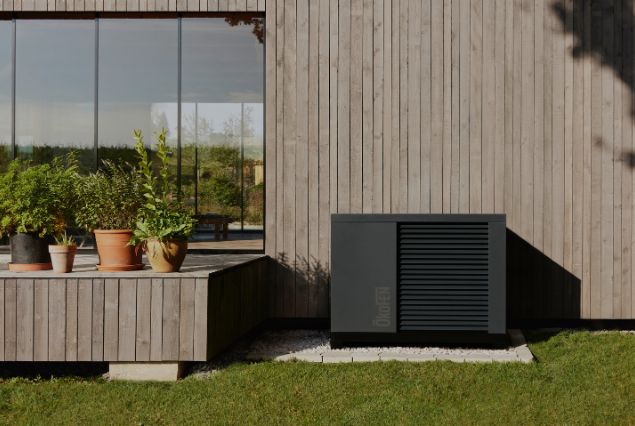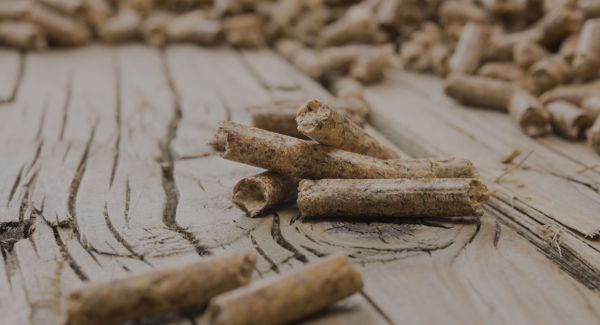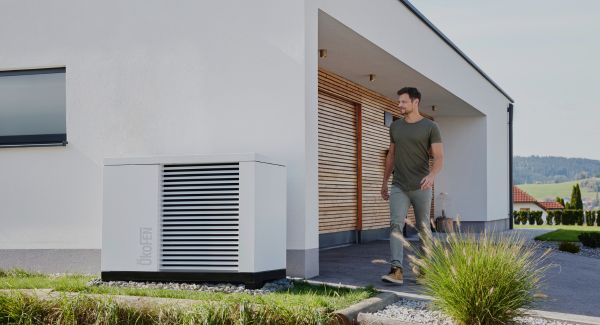Die Heizsysteme Pelletheizung und Wärmepumpe im Vergleich
Bei einem Neubau oder einer Sanierung werden oft Wärmepumpen und Pelletheizungen als alternative Heizsysteme miteinander verglichen. ÖkoFENs direkter Vergleich von moderner Pelletheizung und Wärmepumpe zeigt die entsprechenden Vor- und Nachteile der jeweiligen Systeme auf.
Tipp: Mithilfe unseres Online-Produktberaters finden Sie ganz einfach heraus, welches der beiden Heizungssysteme am besten zu Ihrer jeweiligen Wohnsituation und Ihrem Heizbedarf passt.
Zum Produktberater
Erdwärmepumpe im Vergleich zur Pelletsheizung:
- Höhere Anschaffungskosten
- Geologische Voraussetzung muss gegeben sein, dh. richtige Bodenbeschaffenheit für Erdwärmenutzung
- Grundstück muss geeignet sein, um Bohrungen oder Kollektorflächen-/gräben anzulegen (schwere Geräte, umfangreiche Erdarbeiten)
- Bohrungen sind genehmigungspflichtig
- Kollektorflächen schränken die Nutzung des Gartens ein
Eignet sich eine Wärmepumpe für mein Zuhause?
Noch unentschlossen, ob eine Wärmepumpe das richtige Heizsystem für Sie ist?
Mit unserem Wärmepumpenberater finden Sie in nur wenigen Klicks heraus, ob eine Installation einer Wärmepumpe unter angegebenen klimatischen und räumlichen Bedingungen geeignet ist.
Unsere ÖkoFEN Ansprechpartner stehen Ihnen, nach Terminvereinbarung, außerdem für eine persönliche Besichtigung und Ersteinschätzung vor Ort zur Verfügung.

Die meist gestellten Fragen im Überblick
Die Antworten auf die am häufigsten gestellten Fragen zu Wärmepumpe und Pelletsheizung haben wir für Sie übersichtlich und umfangreich beantwortet. Damit können Sie sich mit absoluter Sicherheit und einem gutem Gefühl für Ihr ideales Heizsystem entscheiden.
Wie viel Platz benötigt eine Pelletheizung?
Eine moderne Pelletheizung braucht heute nur mehr wenig Platz. Auf etwa 3,7 m² bringen Sie Ihre Pelletheizung inklusive hygienischer Warmwasserbereitung und Pellets-Gewebetank unter. ÖkoFEN Pelletheizungen sind zudem so leise, dass sie ohne Bedenken im Erdgeschoss platziert werden können, sollten Sie keinen Keller haben. Fehlt Platz im Gebäude können Sie Ihre Pellets mit unserem Flexilo Outdoor auch im Freien lagern. Im Vergleich dazu nimmt Ihnen die Wärmepumpe keinen Platz im Gebäude weg, da sie meist vor dem Haus oder im Garten platziert wird. Jedoch sollte bei der Anschaffung einer Wärmepumpe die Geräuschentwicklung während der Heizperiode bedacht werden.
Wie viel kostet eine ÖkoFEN Pelletheizung?
Pauschal beantwortet: ÖkoFEN Pelletheizungen kosten je nach Ausführung für ein Einfamilienhaus zwischen 17.000 und 24.000 Euro inklusive Pelletslager (Gewebetank), Fördertechnik, Warmwasserbereitung, Montage und Inbetriebnahme. Zudem erleichtern Förderungen seitens der Bundelsänder den Umstieg.
Ist eine Pelletsheizung wirklich klimafreundlich?
Im Privatbereich hat ökologisches Heizen einen besonders positiven Effekt auf unser Klima und das, ganz ohne auf Komfort verzichten zu müssen. Das Heizen mit Holz ist eine klimafreundliche Art das Eigenheim warm zu halten. Denn bei der Verbrennung von Holz wird nur soviel CO2 freigesetzt, wie es auch bei der natürlichen Verrottung des Baumes freigesetzt würde. Dazu kommt, dass Pellets in Österreich aus 100% Säge-Reststoffen gepresst werden, dh. kein Baum wird extra für die Herstellung von Pellets gefällt. Es wird lediglich ein Produkt genutzt, welches sonst als ungenutzer Abfall übrig bliebe. Diese Umstände führen zu einem besonders guten Gewissen beim Heizen. Regionale Ressourcen werden sinnvoll und mit Rücksicht auf das Klima genutzt.
Mehr zur klimafreundlichen Pelletheizung

Ist das Heizen mit einer Wärmepumpe klimafreundlich?
Finden Sie heraus, wie Sie mit einer Wärmepumpe nachhaltig und effizient heizen können und welche Vorteile das Heizen mit sich bringt.
Heizen mit Strom
Here you'll find the most frequently asked questions (& answers) about heating with pellets.
Would you like a quick overview of heating with pellets? Or do you need well-founded answers for your sales pitch? You’ll always find what you’re looking for in our FAQs.
In short, for ecological, economic and ideological reasons. The combustion of wood pellets is CO2-neutral. In other words, they release the same amount of CO2 during their combustion as the tree had previously absorbed from the air and converted to oxygen.
Heating with wood pellets is sustainably cost-effective. Since the price of pellets is not coupled with the oil price, but determined by the market forces of supply and demand, it is predictable and has constantly been cheaper than heating oil for many years.
Wood is a regional raw material and the wood pellet industry is well-developed. This results in several benefits for consumers: They are supporting the regional economy and creating jobs. In contrast to oil, which is predominantly supplied from crisis regions such as the Middle East, or compared to gas, the supply of which likewise depends on political decisions in foreign countries, owners of pellet boiler systems heat with a reliable fuel.
The best thing about a pellet boiler: For all these benefits, it provides practically the same level of convenience as an oil or gas heating system, and it can also be implemented flexibly: both in family homes and in the commercial and industrial sector. A pellet heating system is always the suitable solution.
Wood pellets are cylindrical pressings made from dry, natural wood waste (wood shavings and sawdust) from the sawmill industry.
They have a diameter of 6 mm and a length of 10 to 25 mm. They are pressed at high pressure – without chemical binding agents – and have an extremely low water content as well as a high energy content and calorific value. Wood pellets are supplied in kilograms. 1 m³ of pellets weighs 650 kg.
In comparison:
2 kg pellets >> approx. 1 litre oil
1 m³ Pellets >> approx. 320 litres oil
The name
No.
Exclusive use is made of waste from wood processing in the production of wood pellets. In the sawmill industry, for example, up to 35 percent of each processed tree remains unused in the form of wood chippings and sawdust. This proportion can be used for pellet production. Furthermore, wood is a renewable resource, and Germany has the largest timber resources in Europe with around 3.6 billion m³. New growth adds another 120 million m³ to this each year. Only around 70 percent of the wood that regrows every year is used at all economically and not even 5 percent in the form of pellets. In addition, legally prescribed, sustainable forest management ensures that over-exploitation of the forests is prevented.
Widely dispersed production and trading structures ensure the availability of pellets throughout Germany.
With annual production of 2.1 million tonnes in 2014, Germany is the country with the highest production volume after the USA. Furthermore, domestic pellet manufacturers produce more pellets than are actually consumed nationally. The remaining amounts are currently exported. In keeping with the number of production facilities, a network of over 300 pellet dealers has developed in the meantime.
In contrast, the provision of oil and gas is anything but sustainable, because fossil fuel supplies are dwindling quicker than expected.
Pellet producers are investing for the future.
The production capacity of German pellet manufacturers is constantly increasing. With new investments, they are bracing themselves for the growing demand. At present some 30 percent of the production volume is exported abroad.
As in all other energy markets, the pellet price is subject to certain fluctuations. However, the diverse supply structure makes the pellet market transparent and consequently very consumer-friendly. The pellet price has remained at a stable level for the last ten years or so, in contrast to fossil energy sources like oil and gas. The oil price doubled in the last eight years, while the pellet price rose by less than 20 percent over the same period.
In general, it is advisable to fill pellet stores in summer, because the price in winter is mostly higher than in warmer months.
The price of pellets is not coupled with the oil price; it is governed by supply and demand.
The pellet price has remained stable in recent years. Independence from stock-market speculation and international crises – which are a matter of course in the trading of fossil fuels – represents another guarantee for the price stability of wood pellets.
Climate-neutral heating is rewarded by the state and state subsidies are available to everyone who converts to a pellet heating system. Pellets are an affordable fuel that amortises the acquisition costs of a new, modern pellet boiler within a few years.
The energy input for pellet production only amounts to approx. 2.7 percent of the calorific value of pellets.
In comparison, the energy input is approximately 12 percent for heating oil and approximately 14.5 percent for liquefied gas.
Since January 2010, the ENplus seal of approval for pellets has guaranteed the efficient, environmentally friendly operation of pellet heating systems.
Dry pellets release significantly more energy than those with a high moisture content. In addition, standardised pellets allow the combustion technology to be set very precisely, so up to 95 percent of the pellet energy content can be utilised. Users who heat with high-grade pellets also benefit from lower cleaning expenditure. With its strict limits, the new standard ensures impeccable pellet quality throughout Europe. For the first time, the entire supply chain from production through to delivery at the end user’s site is monitored, thereby guaranteeing greater consumer protection. Apart from the calorific value, the standard also defines the water content, ash content, length, diameter and other criteria. So, when purchasing pellets, make sure that they bear the ENplus and DINplus seals of approval – the corresponding quality criteria are binding for the certified manufacturers. Further information can be found at www.enplus-pellets.de
The calorific value of pellets is standardised at 4.9 kWh/kg.
The calorific value of one litre of extra-light heating oil is 10 kWh/l and that of 1 m³ natural gas is also 10 kWh.
Therefore: 2 kg pellets ~ 1 litre extra-light heating oil ~ 1 m³ natural gas.
Fundamentally, there are two options: A storage tank made of high-quality polyester fabric or a pellet storage room.
The storage tank is quick and easy to install, cost-effective and dust-tight. Furthermore, the fabric is permeable to air, which makes the tank the perfect storage option for pellets. If it is protected from sun and rain, it can even be sited outside the building. Moreover, innovative storage tanks have 60 percent more storage capacity for the same space requirement. Pellets are delivered by tanker, from which the pellets are blown into the storage room or tank by compressed air. In contrast to oil, pellets cause no unpleasant smells and are stored cleanly with accustomed convenience.
Pellets can be stored indefinitely when stored in dry conditions.
Not only the pellets themselves need to be high quality, but also the equipment and design of the storage room.
The walls, floor and ceiling of the store must therefore be absolutely dry, as otherwise the wood pellets could swell up and fall apart. Damp pellets can lead to malfunctions during transport from the store to the pellet boiler, as well as during combustion.
In the case of a separate pellet storage room, a smooth sloping floor with a minimum inclination of 45 degrees must always be installed. If no sloping floor is provided, the inclination is too shallow or the surface too rough, then pellets can become stuck.
The pellets above this layer slide over the static pellets, with the remaining wood pellets acting as a sieve.
No combustion takes place without any emissions.
However, the combustion in pellet boilers is CO2-neutral, because only as much carbon dioxide is released as the tree absorbed previously during its growth and would release in the natural rotting process. CO2 emissions are therefore very low. In addition, pellet boilers already comply with the limits for fine dust stipulated in the stricter Federal Emission Control Act (BImSchV) which apply from 2020. Combustion monitoring, automatic fuel feed and air regulation – in conjunction with the standardised dry fuel made of natural wood without additives – mean that pellet heating systems can already meet these strict criteria today, without any filters.
Consumers benefit from the investment in a new heating system over 15 to 20 years – they want a future-proof heating system with predictable fuel costs.
With an additional product range, you can offer your customers a wider selection, which, in turn, makes you more attractive. If you take an extra step and specialise in pellet heating systems, you can even create a unique selling point for yourself compared to your local competitors. As a specialist in regenerative fuels, you can broaden your customer base.
Pellet boilers are flexible in their application and suitable for every heating system. Be it for radiators, wall or underfloor heating, for family homes or commercial buildings. For buildings without cellars or if the available space is intended for use as valuable living or storage areas, ÖkoFEN can supply heating centres for outdoor installation.
The systems solutions from ÖkoFEN, comprising pellet boiler, solar collector and suitable buffer cylinder, simplify the planning process for every specialist heating company, require less installation time thanks to pre-installed components and ensure their customers a functional, homogeneous system. ÖkoFEN’s nationwide customer service network guarantees short journeys and rapid response.

 Menue
Menue


